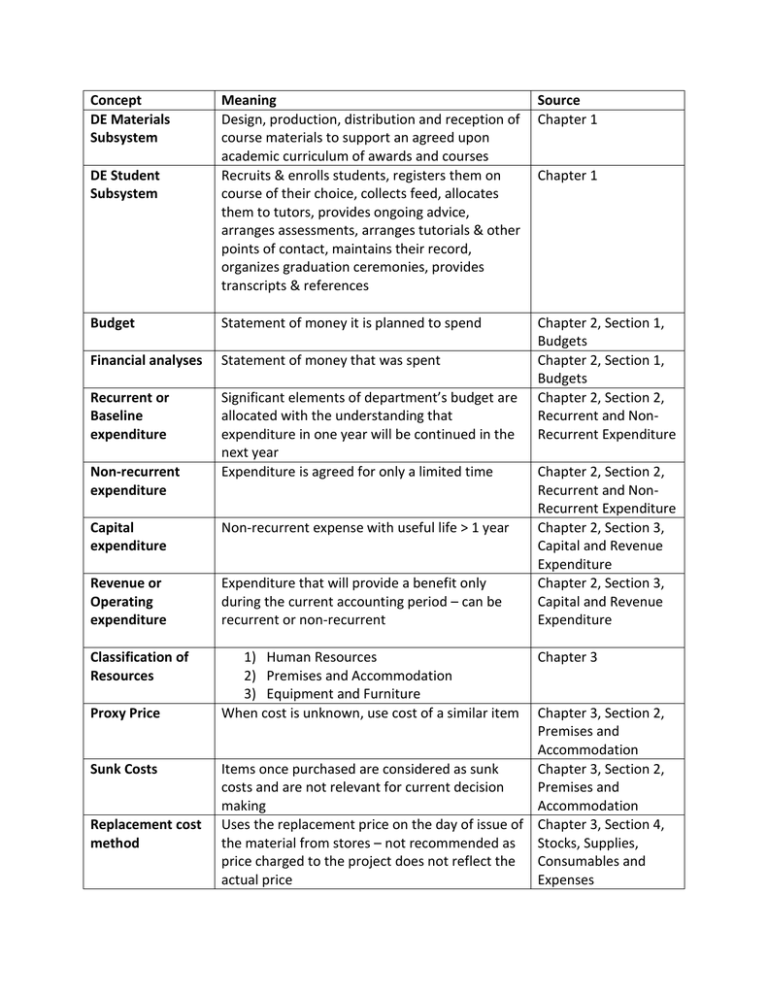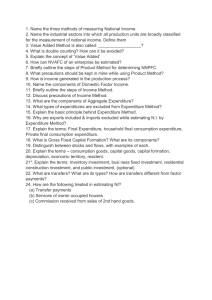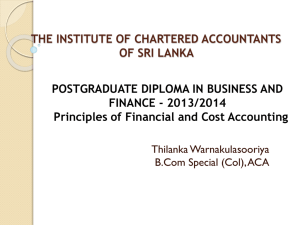Concept Meaning Source DE Materials Subsystem Design
advertisement

Concept DE Materials Subsystem Meaning Design, production, distribution and reception of course materials to support an agreed upon academic curriculum of awards and courses Recruits & enrolls students, registers them on course of their choice, collects feed, allocates them to tutors, provides ongoing advice, arranges assessments, arranges tutorials & other points of contact, maintains their record, organizes graduation ceremonies, provides transcripts & references Source Chapter 1 Budget Statement of money it is planned to spend Financial analyses Statement of money that was spent Recurrent or Baseline expenditure Significant elements of department’s budget are allocated with the understanding that expenditure in one year will be continued in the next year Expenditure is agreed for only a limited time Chapter 2, Section 1, Budgets Chapter 2, Section 1, Budgets Chapter 2, Section 2, Recurrent and NonRecurrent Expenditure DE Student Subsystem Non-recurrent expenditure Capital expenditure Non-recurrent expense with useful life > 1 year Revenue or Operating expenditure Expenditure that will provide a benefit only during the current accounting period – can be recurrent or non-recurrent Classification of Resources 1) Human Resources 2) Premises and Accommodation 3) Equipment and Furniture When cost is unknown, use cost of a similar item Proxy Price Sunk Costs Replacement cost method Chapter 1 Chapter 2, Section 2, Recurrent and NonRecurrent Expenditure Chapter 2, Section 3, Capital and Revenue Expenditure Chapter 2, Section 3, Capital and Revenue Expenditure Chapter 3 Chapter 3, Section 2, Premises and Accommodation Items once purchased are considered as sunk Chapter 3, Section 2, costs and are not relevant for current decision Premises and making Accommodation Uses the replacement price on the day of issue of Chapter 3, Section 4, the material from stores – not recommended as Stocks, Supplies, price charged to the project does not reflect the Consumables and actual price Expenses Average price method first in, first out (FIFO) Calculates the total price paid for all the items in the inventory and divides this by the number of items in the inventory to arrive at an average price per item Assumes stores will always issue the oldest stock first Notational Cost A range of estimated cost Actual Cost The actual cost incurred Cost Unit A measured amount of product or service used for the expression of the costs of that product or service Cost of one measure of output Unit Cost Cost Centers Total Cost Direct Costs Cost attributed to location, functions or items of equipment Sum of all the costs attributed to the cost unit or cost center under consideration Costs directly related to creating the finished product Direct Materials Raw materials or components that become part of the finished goods or used with in delivery of OR supplied with final product Direct Labor Cost of work done by people where the work can be attributable to a particular product or service Direct Expenses Items such as subcontracted work or special tools or equipment with a particular product or service Indirect Expenses Costs cannot be directly attributed to one product Overhead Costs Any cost other than a direct cost Fixed Costs Costs that do not increase or decrease with changes in the level of activity Chapter 3, Section 4, Stocks, Supplies, Consumables and Expenses Chapter 3, Section 4, Stocks, Supplies, Consumables and Expenses Chapter 4, Section 1, Cost Chapter 4, Section 1, Cost Chapter 4, Section 1, Cost Chapter 4, Section 1, Cost Chapter 4, Section 1, Cost Chapter 4, Section 1, Cost Chapter 4, Section 2, Direct Costs, Indirect Costs, and Overheads Chapter 4, Section 2, Direct Costs, Indirect Costs, and Overheads Chapter 4, Section 2, Direct Costs, Indirect Costs, and Overheads Chapter 4, Section 2, Direct Costs, Indirect Costs, and Overheads Chapter 4, Section 2, Direct Costs, Indirect Costs, and Overheads Chapter 4, Section 2, Direct Costs, Indirect Costs, and Overheads Chapter 4, Section 3, Fixed Costs, Variable Semi-variable Costs Costs that may vary with significant changes in the level of activity Relevant Range Range of activity in which costs are unchanged Variable Costs Costs directly affected by increase or decrease in activity Marginal Cost Cost of adding just one unit of output – usually associated with direct cost (Section 5.4) Cost Driver Anything that, following a change in its volume, causes the overall cost to change Occurs wherever the unit cost of production of goods or services does not rise in direct proportion to the increase in output of the goods or services; variable costs flatten out as economies of scale are reached Those that cannot be eliminated or cut back without a major effect on the enterprises objectives or profits Costs which can be reduced fairly easily without any immediate major disruption to the objectives or profits of the organization Economies of Scale Committed Costs Managed Costs: Costs and SemiVariable Costs Chapter 4, Section 3, Fixed Costs, Variable Costs and SemiVariable Costs Chapter 4, Section 3, Fixed Costs, Variable Costs and SemiVariable Costs Chapter 4, Section 3, Fixed Costs, Variable Costs and SemiVariable Costs Chapter 4, Section 3, Fixed Costs, Variable Costs and SemiVariable Costs Chapter 4, Section 4, Cost Drivers Chapter 4, Section 5, Variable Costs, Linearity and Economies of Scale Chapter 4, Section 6, Committed and Managed Costs Chapter 4, Section 6, Committed and Managed Costs Total Cost Formula (Eq 5.1) Total cost = Fixed Costs + (Variable Cost Per Unit * Number of Units) Chapter 5, Section 2, Average Costs Average Cost Formula (Eq 5.2) Average Cost Formula (Eq 5.3) Average cost = Total Cost/Number of Units Average cost per unit = Variable Cost per unit + (Fixed Cost/Number of Units) Chapter 5, Section 2, Average Costs Chapter 5, Section 2, Average Costs Incremental Cost Additional cost of adding an incremental amount of units (> 1) Break Even = Fixed Costs/Variable Costs Chapter 5, Section 4, Marginal Costs Chapter 5, Section 5, Break Even Point (Eq 5.4) Break Even Point (2) (Eq 5.5) Depreciation Written Down Value or Net Book Value Social discount rate Break Even = (Fixed Costs1 – Fixed Costs2)/(Variable Costs2 – Variable Costs1) The monetary value of the wearing out or loss of value of capital goods arising from use, the passage of time and technological or market obsolescence Subtracting the total depreciation to date from the historical cost Break-Even Chapter 5, Section 5, Break-Even Chapter 6, Section 1, Depreciation Chapter 6, Section 1, Depreciation An opportunity cost or value of that which must be given up to acquire or achieve something Chapter 6, Section 2, Social Discount Rate Approach to calculating opportunity cost Approach for including the opportunity cost in deprecation: 1. Determine the replacement value of the item 2. Determine the useful life of the item 3. Divide the replacement value of the item by the number of years of life to obtain the cost of depreciation for each year of use 4. Multiply the undepreciated portion by the interest rate to obtain the opportunity cost of having resources invested in the undepreciated portion of the item 5. Add the annual cost of the depreciation and the annual interest foregone on the remaining investment to obtain the annual cost Chapter 6, Section 2, Social Discount Rate Annualization Formula (Eq. 6.1) Annualization Rate (r,n) = r (1+r)n /(1+r)n - 1 Chapter 6, Section 3, Annualization Factor Where: Cost Allocation R = Prevailing rate of interest expressed a percentage N = Life of capital equipment expressed as a whole number The process of allocating costs that are readily identifiable as belonging to a cost center, product or customer Chapter 7, Section 1, Direct and Indirect Costs and their Cost Apportionment Dividing overhead across cost centers when direct benefit is not possible or worthwhile Cost Absorption Assigning overhead costs to the products Cost Objects Reasons for performing activities. For example, products, services, customers The processes or procedures that cause work Activity Relation to Products and Services Chapter 7, Section 2, Traditional Management Accounting Chapter 7, Section 2, Traditional Management Accounting Chapter 7, Section 4, Activity-Based Costing Chapter 7, Section 4, Activity-Based Costing





